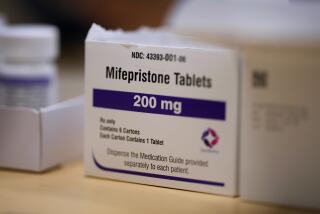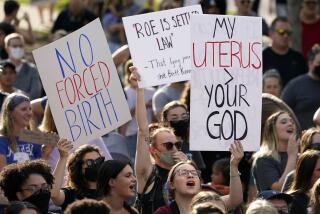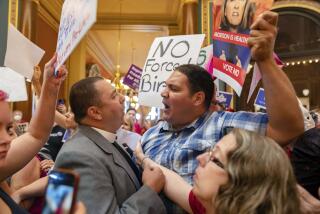Democratic Candidates Still Lamenting Hard Times : Iowa Economy Beginning to Boom
- Share via
DES MOINES — Listen to the Democratic presidential candidates talk about the economy of Iowa, and visions of a broken state rise up before you.
The Iowa of their rhetoric is a place where countless bankruptcies and foreclosures still threaten the very survival of the American family farm, a state where factory jobs have become so scarce that legions of unemployed leave for the Sun Belt each month.
Their Iowa is, in other words, not just a key state in the presidential campaign--the site of the nation’s first Democratic caucuses on Feb. 8--but part of an ailing middle America that badly needs the Democrats’ help.
Jobless Rate Falling
But in fact, Iowa is beginning to emerge into a full-blown economic boom. Consider just part of the mounting evidence: The state’s jobless rate has fallen from 7% to 4.6% in the past year. Personal income surged 9.7% in the first quarter of 1987, contrasted with a national average of just 1.7%. Iowa farm income is now rising at better than a 25% annual rate, while more than 88,000 new non-farm jobs have been created in the past year.
To top it off, the federal government reported earlier this month that Iowa City had the lowest unemployment rate of any city in the nation, with just 1.8% of its labor force unable to find work.
Many economists and state officials here contend that the oratory of doom and gloom of the Democratic presidential candidates is a lagging economic indicator in Iowa.
“They are coming in from the outside, and news travels slowly, I suspect,” sighed Harvey Siegelman, chief economist for Iowa’s state government.
‘Puzzles Us All’
“I think their speeches don’t match the reality,” added Bob Boyd, communications director for the Iowa Department of Economic Development. “It puzzles us all.”
Missouri Rep. Richard A. Gephardt often tells hushed crowds the story of an Iowa farmer whose son hanged himself from the rafters of a barn after the family lost its farm. “The heart of America’s heartland is being torn out,” warned Gephardt, who repeatedly stresses that Iowa and the Midwest need his tough trade and farm policies to recover.
Massachusetts Gov. Michael S. Dukakis frequently contrasts the Midwest’s problems with the boom in his home state, and tells his audiences here that he is the man to bring New England-style prosperity back to middle America.
Illinois Sen. Paul Simon stopped to pull down a hand-scrawled “work wanted” sign posted by a roadside during one recent campaign swing, and later dramatically held it aloft as he spoke at a rally. “We need federal policies that encourage the development of a small and varied industrial base in rural communities so that young people who grow up there will have more of a chance for working and staying in those communities,” he said.
Working Part Time
Former Arizona Gov. Bruce Babbitt, meanwhile, likes to paint a very personal picture of Iowa’s woes for his listeners here. “I have a friend named Russ Anderegg, whose son and daughter-in-law must work part-time jobs to keep their farm solvent,” Babbitt said. “It’s wrong, and it’s time to refocus farm programs before family farmers and our American agricultural tradition melt away.”
Such rhetoric is likely to continue despite the ever rosier statistics, Democratic strategists say. “Those indicators (of a recovery) may be very real, but the problems are still fresh in people’s minds in Iowa, and not everyone who was hurt has been helped,” said Donald Foley, Gephardt’s press secretary. “The experience (of the farm crisis) in Iowa has been so real and vivid that it would be a mistake for any of the candidates to talk as if they are ignoring the real plight the people have had.”
There are still plenty of Iowans, both farmers and city dwellers, who share the candidates’ perception of the state as one still struggling through a farm crisis. And leaders here say even people who are doing well often don’t like to let anyone know about it.
As a result, Iowa voters still seem to love it when candidates tell them how bad things are in their own state.
Dramatic Turnaround
“What has happened in the last year has really been a turnaround,” said Iowa Gov. Terry E. Branstad. “But Iowans are different from people in California--they are afraid to admit they are making money. They are afraid of what the neighbors will say.”
“Doom and gloom plays better than you might think here, because the farmers are concerned the bad times will come back soon,” added Neil Harl, an economist and agricultural expert at Iowa State University.
Still, if the Iowa economy continues to grow at its current pace, the recovery will soon be hard for the candidates and the voters here to ignore.
In the farm sector, which led Iowa into its slump in the early 1980s, the turnaround has been especially dramatic. Agriculture, in fact, is now the engine pulling Iowa out of its recession.
Farm Values Increase
Buoyed by huge federal subsidies, the number of Iowa farmers in serious trouble has sharply declined over the last year, noted Harl. Farmland values in Iowa rose 2% in the second quarter of 1987, the first increase in at least five years; land values in north central Iowa, which boasts some of the most fertile soil in North America, rose 4% in the same three-month period.
Meanwhile, hog production, a major source of income for Iowa’s farmers, is more profitable than at any time in history, thanks to a federal program that keeps livestock feed prices low. “People say that if you can’t make money in livestock in Iowa now, you should get out of farming,” economist Siegelman said.
The surge in farm profits has so far been slow to work its way through the rest of Iowa’s economy, because many troubled farmers are using their new earnings to pay off their debts. But some of the more prosperous farmers are starting to use their cash to invest once again in new land and new equipment, Harl believes.
Machinery Orders Rise
Farm machinery orders are thus picking up for the first time in years, helping to stabilize John Deere and other major Iowa manufacturing employers. “Things are more positive than they were two years ago,” agreed Gaylord Jones, a John Deere equipment dealer in Woolstock, Iowa. Federal agricultural subsidies now amount to approximately $25 billion annually around the nation. The 1985 farm bill that laid the foundation for the recovery in Iowa was enacted under the Reagan Administration with strong support from Sen. Bob Dole of Kansas, Republican presidential hopeful.
But just as farmers are slow to recognize better times, so are they reluctant to praise Republicans for bailing them out. Most polls in the state still reflect a belief that the GOP is not sympathetic to farmers, in part, because the Administration was planning to phase out subsidies just as the farm crisis hit, and then took so long to reverse its course.
Still, there is a glimmer of hope for some GOP aspirants, especially Dole.
The farm bill “has been a wonderful thing,” said Dennis Peterson, a 52-year-old farmer in Dows, Iowa. “It is bailing out a lot of us. Some people are still complaining that the government isn’t helping us. But they are doing everything they can.
“I feel comfortable right now,” said Peterson, who grows both corn and soybeans but keeps 35% of his 780 acres out of production as part of a federal program designed to reduce crop surpluses and increase prices. “I’m leaning to the Republicans, and I’d kind of like to see Bob Dole get in there. I think he knows agriculture about as good as any of them.”
Staff writer John Balzar also contributed to this story.
More to Read
Get the L.A. Times Politics newsletter
Deeply reported insights into legislation, politics and policy from Sacramento, Washington and beyond. In your inbox three times per week.
You may occasionally receive promotional content from the Los Angeles Times.










